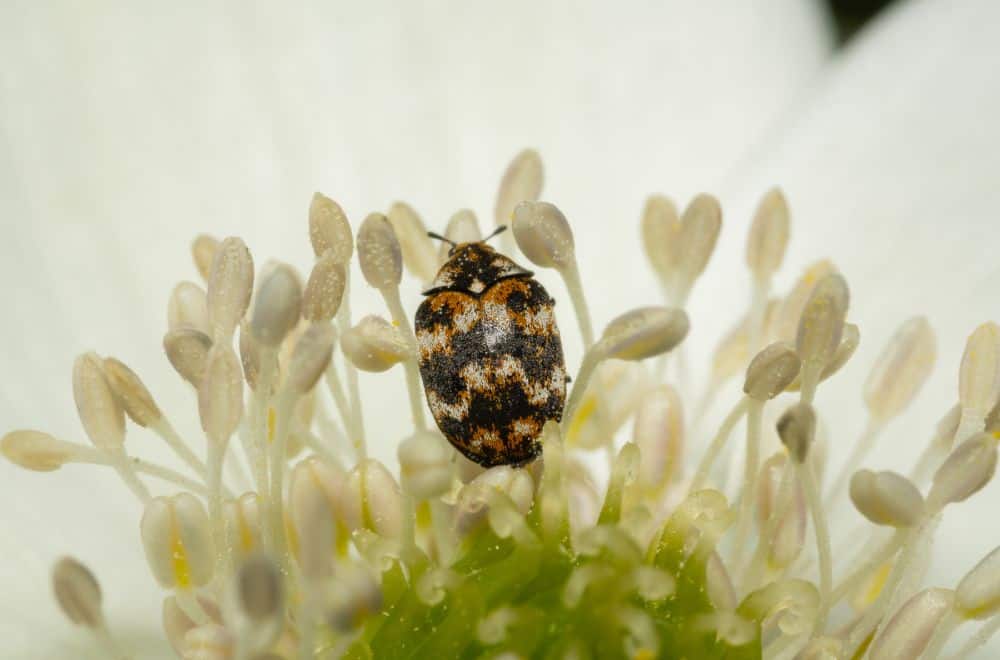Knowing that your home is a comfortable breeding ground for pest insects, like Carpet beetles, is unpleasant. This species is harmless for your health, but larvae can destroy your clothing, curtains, linen, and upholstery.
When finding traces of adult Carpet beetles in the bed, you can be sure their eggs and larvae feeding on natural fibers are all around. Therefore, you should do your best to get rid of them before they cause irreparable damage.
Carpet beetle traits |
|
| Size | 0.12 to 0.19 inches (3 – 4.8 mm) on average |
| Color | Shiny brown or black and mottled pattern variation of white, yellow, orange, and brown |
| Shape | Round or spherical body |
| Eyes | Round and bulgy |
| Antennae | A pair of short clubbed antennae |
| Wings | A pair of wings with shiny and reddish-yellow hard elytra (wing cases) |
| Legs | Three pairs of reddish-brown legs |
| Larvae | Hairy, 0.31 inches (7.9 mm) long, wingless |
| Diet | Adults – plant pollen
Larvae – animal fibers (fur, wool, silk, and feathers), hair, dried flowers, and stored food, including pet food |
| Infestation signs | Visible dead adult beetles near the window, translucent shed skins, and holes in natural fabrics |
| Carpet beetle source | Dry pet food, old clothes, and wool blankets |
Ways to Identify Carpet Beetles and Their Larvae
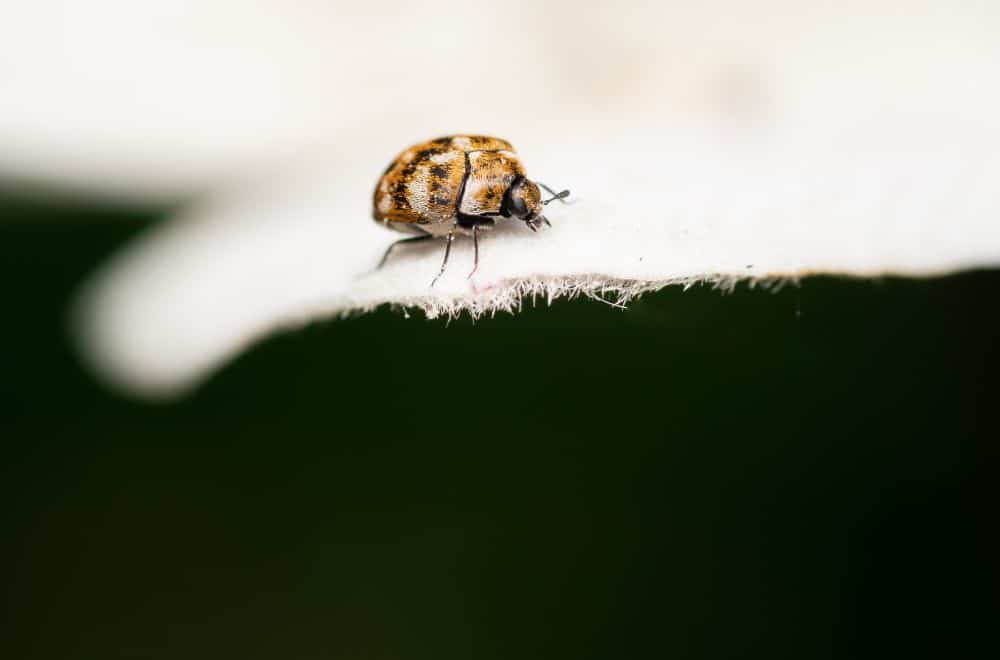
Carpet beetles are common oval-shaped indoor pest insects from the Dermestidae beetle family, coming in two genera – Attagenus and Anthrenus.
Most are black or with yellow-white spotted calico patterns. They have a hidden head with round bulgy eyes, a hard outer shell, antennae, a pair of wings, and six legs. They lay over a hundred white, oval eggs approximately under 0.04 inches (1 mm) long, primarily on wool and fur.
Brownish larvae (woolly bears) are often longer than adults and have hundreds of tiny hairs over their bodies, including long, ponytail-like hairs at the end. You can find them practically everywhere, including your closets, carpets, air vents, and beds.
Carpet beetles |
|||
| Type | Latin name | Adults | Larvae |
| Black Carpet beetle | Attagenus unicolor | 0.12 to 0.20 inches
(3 – 5 mm), black |
0.28 inches (7 mm), reddish-brown, covered with bristles |
| Brown (vodka) Carpet beetle | Attagenus smirnovi | 0.08 to 0.24 inches
(2 – 6 mm), brown-black |
0.02 to 0.4 inches
(0.5 – 10 mm), bronze-brown |
| Two-spot (fur) Carpet beetle | Attagenus pellio | 0.20 to 0.24 inches
(5 – 6 mm), black |
0.02 to 0.4 inches
(0.5 – 10 mm), brown |
| Varied Carpet beetle | Anthrenus verbasci | 0.07 to 0.14 inches
(1.7 – 3.5 mm), patterned |
0.12 to 0.25 inches
(3 – 6.3 mm), tan to brown with stiff hairs |
| Common Carpet beetle | Anthrenus scrophulariae | 0.06 to 0.12 inches
(1.5 – 3 mm), gray to black |
0.10 to 0.22 inches
(2.5 – 5.5 mm), reddish-brown covered with dark hairs |
| Furniture Carpet beetle | Anthrenus flavipes | 0.08 to 0.14 inches
(2 – 3.5 mm), black with white and yellow mottling |
0.12 to 0.25 inches
(3 – 6.3 mm), tan to brown with stiff hairs |
Unlike some other species, Carpet beetles are entirely harmless to you and your pets. Unfortunately, their larvae will destroy your clothes, linen, and carpets made of natural fabrics.
Adults like light, and you can spot them in brightly lit areas, often on the furniture surface. On the other hand, larvae enjoy hidden places, and spotting them can be challenging.
What Attracts Carpet Beetles to Live in Beds?
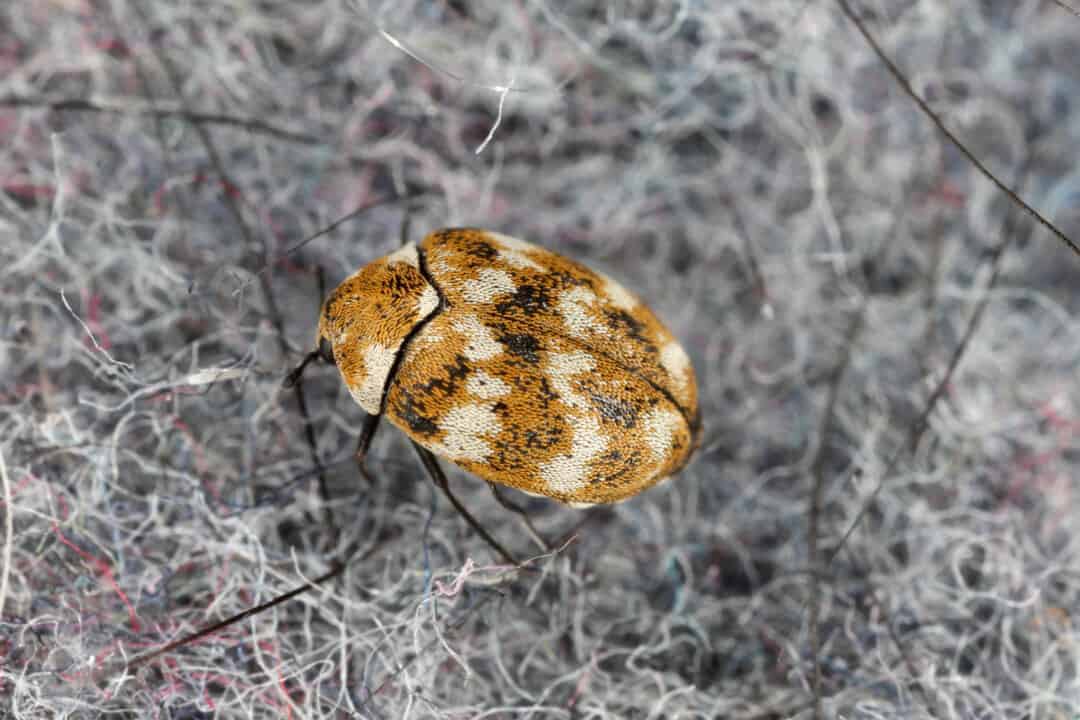
Image Credit: pestpointers
Carpet beetles like light and warm rooms, so they often come inside the house to find a comfy environment to live, breed, and lay eggs. The most common ways of entry are on your clothes and pet’s fur since sweat odor, dead skin, oils in human hair, and pet hair attract these oval-shaped insects.
Once they come into your home, you can expect to see these bugs on your bed. The quickest way to bring them is to jump onto the couch or bed without removing your clothes or when letting your dog lie there. Since Carpet beetles like fur, sleeping with your pets in the same bed will attract them to join.
Unlike adults that feed on plant pollen and nectar, larvae enjoy consuming natural animal fibers. Besides enjoying wool carpets, they will cause damage by feeding on your clothes, linen, and blankets made of:
- Wool, felt, and silk
- Leather and fur
- Feathers
They also enjoy nibbling:
- Hair brushes with natural bristles
- Pet fur
- Fabrics stained with animal products
- Human and animal debris
Even though larvae avoid synthetic fibers, they sometimes consume mixed fabric containing a certain percentage of wool. Adults can live in your bed and mattress without causing any damage. On the other hand, you can expect voracious larvae to ruin the following:
- Your bed and linen
- Blankets, upholstery, and curtains
- Carpets and rugs
- Couch, bed headboard, and chairs
- Clothing
- Books
Once you notice tiny holes in these materials and furniture, you can be sure that you have to deal with an infestation. Besides material damage, Carpet beetles and their larvae may cause severe allergic reactions.
While adults are harmless for your health and never bite, their prickly and hairy larvae often cause skin redness and itchy rash. Long-term inhalation of their droppings, hair, and shed shells also often leads to lung irritations.
Check your pillowcases and blankets for eggs. Since one female lays approximately 50 to 100 tiny white eggs away from light sources, you can expect to find large clusters:
- On the bed box spring
- Along skirting boards
- Under mattresses
- In shady corners
One of the reasons why Carpet beetles are hard to control is the variety of ingredients they consume. When lacking their primary food, larvae can also feed on:
- Stored food and milled products
- Dead insects
- Cereals and seeds
- Pet food
- Felt and lint
- Dirty clothing
- Crumbs
Therefore, you can often bring larvae into your home with infected groceries and various materials.
Are Carpet Beetles Harmful to Humans and Pets?
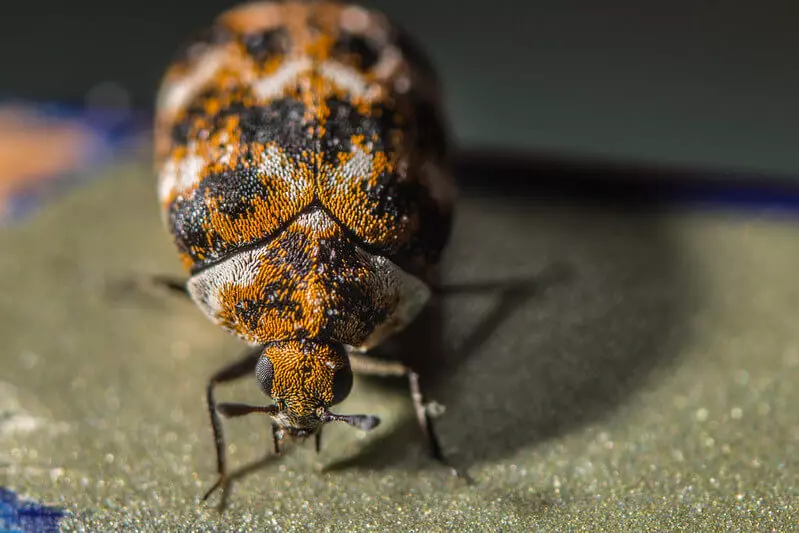
Image Credit: fantasticpestcontrol
Adult Carpet beetles are not blood-sucker insects and are harmless to humans and animals. On the other hand, their larvae may cause an allergic reaction and dermatitis in highly sensitive individuals.
Remember that tiny, mosquito bite-like red spots on your legs are not a result of biting but a reaction to larvae hair and molted skin. They often irritate human skin and cause an allergy.
Only rare people overreact after their eyes, skin, airways, and digestive tract come in contact with larvae and their secretions. Typical symptoms include:
- Red, watery, and itchy eyes
- Itchy skin, rash, and hives
- Runny nose
- Gastrointestinal issues
All symptoms will disappear as soon as you eliminate Carpet beetles and their larvae from your home. After long-lasting exposure, you can also become desensitized and keep living with these insects in the same house without consequences.
Ways to Differentiate Carpet Beetles and Bed Bugs
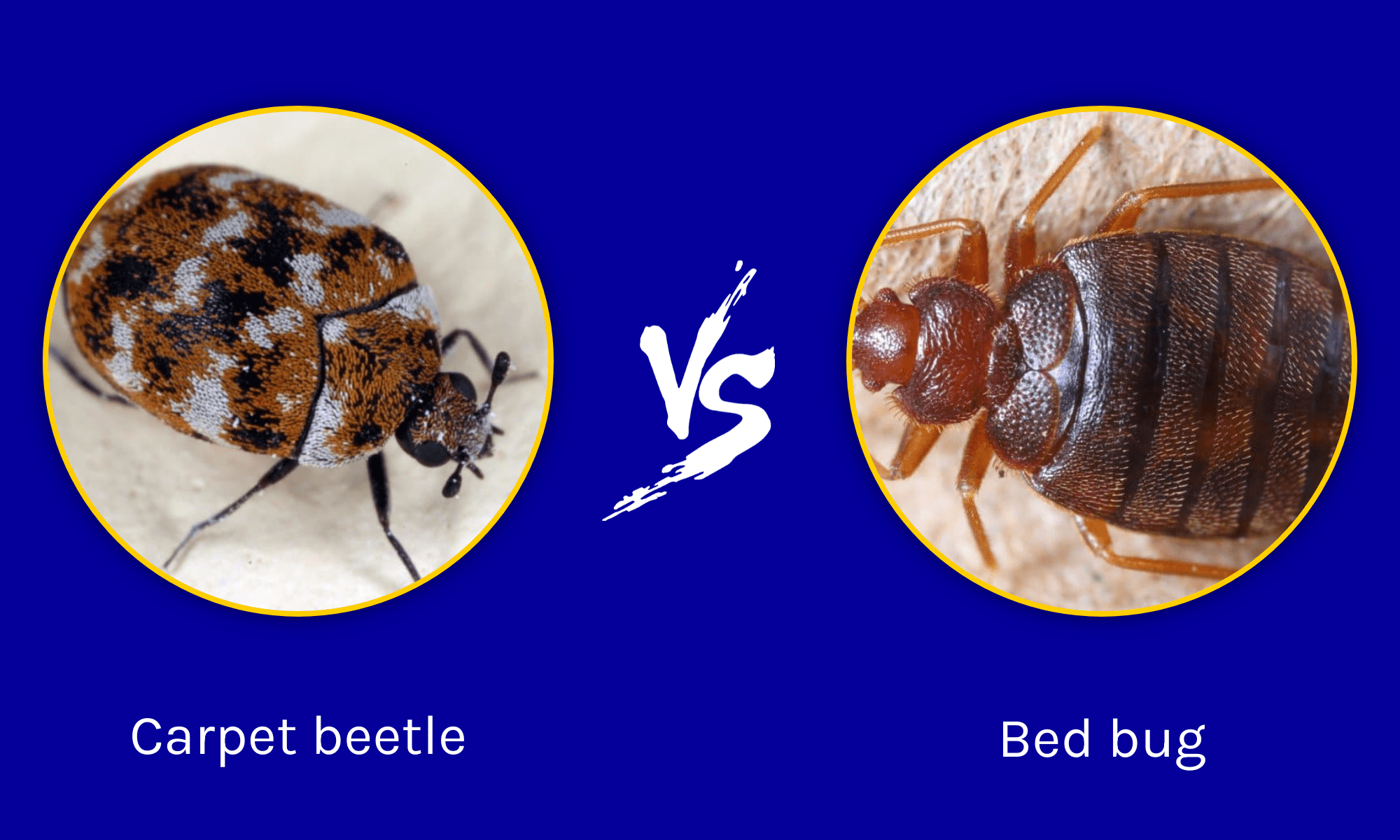
Image Credit: a-z-animals
Many confuse Carpet beetles and Bed bugs and are unsure what bug type crawls and lays eggs in their beds. They are approximately the same size and color and have similar habits.
The primary difference is that adult Carpet beetles feed on pollen and nectar and never bite humans. On the other hand, Bed bugs can’t grow and reproduce without sucking human blood. The only way to differentiate these two species is to inspect them closely.
Carpet beetles are 0.12 to 0.19 inches (3 – 4.8 mm) long, shiny brown or black oval-shaped insects with wings. A magnifying glass lets you recognize mottled pattern variations of white, yellow, orange, and brown.
Bed bugs are 0.19 to 0.25 inches (4.8 – 6.3 mm) long red-brown, wingless insects with flat, oval-shaped bodies.
Ways to Get Rid of Carpet Beetles
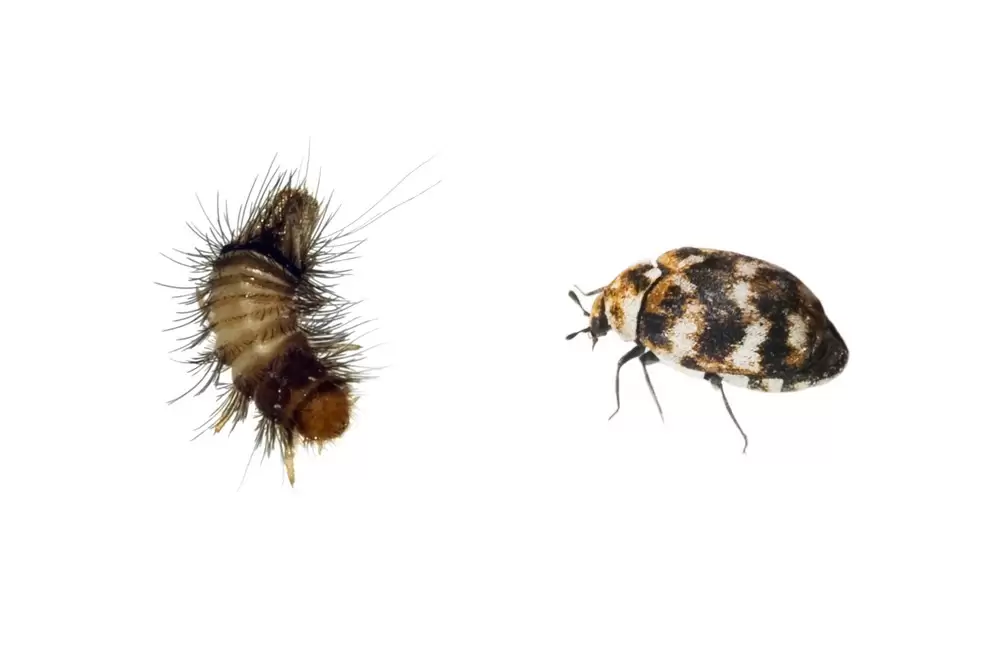
Image Credit: pestdefence
Fortunately, you can find numerous ways to eliminate Carpet beetles and their larvae from your home and bed. Be persistent and thorough since it is the only way to get a satisfying result.
1. Clean the house
- Wash linen, clothes, and upholstery in hot water or a washing machine
- Wash fibrous items in hot water after previously freezing them
- Dry-clean clothes, blankets, and upholstery you can’t wash
- Keep fabrics like wool, cotton, feather, silk, and felt in airtight bags
- Eliminate houseplants since Carpet beetles feed on nectar and pollen
- Thoroughly clean infected areas to eliminate larvae
- Check the cushions’ creases and seams undersides and wash them
- Vacuum mattresses, furniture, and carpets, particularly next to windowsills and doors
- Clean vents to remove larvae and lint
- Check the carpets’ underside for larvae and remove them
- Use a steam cleaner to clean floors and other hard surfaces
2. Natural remedies
Essential oils – Drip clove or peppermint oil in distilled water and pour the solution into a spraying bottle. Then, spray areas with increased Carpet beetles and their larvae activity.
Cider or white vinegar – Since Carpet beetles hate their scent, vinegar will keep them away from your home. Make a solution of equal amounts of vinegar and water and spray infected locations.
Baking soda – This powder is an effective solution for eliminating Carpet beetles. Since it dehydrates adult insects and kills them almost instantly, you should simply dust it over the affected area and remove dead bugs afterward.
Rubbing alcohol – Wipe down windowsills, shelves, cupboards, drawers, and counters with rubbing alcohol to eliminate these insects.
Boric acid – Sprinkle it on your carpets and furniture to kill Carpet beetles. Then, remove dead insects with a brush after a couple of hours.
Bleach – Make a cleaning solution of bleach and water in a 1: 3 ratio to kill eggs and larvae.
3. Diatomaceous earth
Sprinkle this fine white dust over your carpets to eliminate Carpet beetles and their larvae. Always pick out a food-grade option with lower crystalline silica content, making it safe for your family and pets.
4. Fogger
Use a flying insect fogger to eliminate Carpet beetles, but remember that foggers only kill adults and can’t destroy eggs.
5. Chemicals
Apply potent insecticide containing deltamethrin, cyfluthrin, or bifenthrin on an affected area to kill Carpet beetles that managed to escape. There are two approaches:
Inside use – You can buy any available aerosol or spray and use them inside your home. Always test a chosen product on a small area first to check whether it leaves hard-to-remove stains on fabric and carpets.
Outdoor use – In this case, your primary goal is to prevent beetles from entering the house. The quickest way is to sprinkle granules on the windowsill, around vents, and next to the door.
6. Professional exterminator
If all methods fail or the infestation is too widespread, your only solution is to call a licensed pest control. Such professionals will apply heavy-duty cleaners to clean all rooms deep and eliminate adult Carpet beetles, eggs, and larvae from your bed.
Ways to Prevent Carpet Beetle Infestation
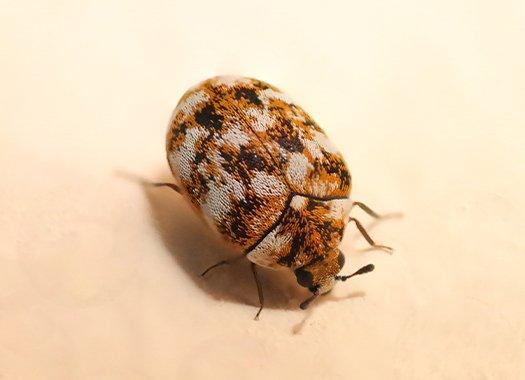
Image Credit: actionpest
You will probably see Carpet beetles in the spring, and one of your primary tasks is to prevent them from invading your home. Remember that prevention is a quicker and more affordable option than eliminating bugs and their larvae once they come inside.
- Regularly wash clothing, towels, bedsheet, pillows, curtains, and blankets
- Purchase a hypoallergenic cover for your mattress
- Store clothing made of natural fabrics and linen appropriately
- Add a few drops of essential oil, several moth balls, or a piece of cedar to the storage bags and boxes
- Use sheets and blankets made of synthetic materials if you live in a region where the possibility of infestation is exceptionally high
- Clean floors and vacuum rugs and carpets in the bedroom daily, and pay particular attention to the area beneath the bed
- Brush your dog and cat regularly, and keep your bed free of their hair
- Keep food, especially flour, rice, and pasta, in tightly sealed containers
- Regularly inspect houseplants when watering them and wipe excessive drops from the foliage
- Shake freshly cut flowers and check them carefully for these pollen-feeding insects and their larvae before putting them into a vase
- Seal existing gaps in the walls and around windows and doors
- Avoid eating in your bed
- Replace worn-out window screens
- Apply a granulated insecticide around entrances, including doors, windows, utility pipes, and vent openings
Summary
Carpet beetles are harmless oval-shaped insects, but their larvae can be annoying when appearing in your bed. Even though they won’t harm your family and pets, you can expect them to destroy your clothes, linen, and carpets made of natural fabrics. Luckily, you can choose among numerous ways to eliminate these menaces and prevent them from invading your home.
